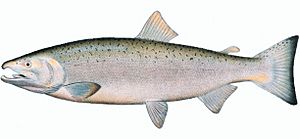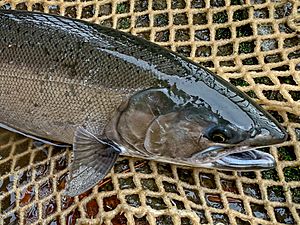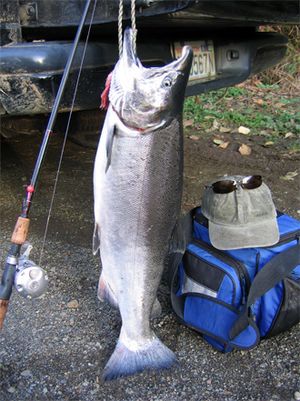Coho salmon facts for kids
Quick facts for kids Coho salmon |
|
|---|---|
 |
|
| Scientific classification | |
| Genus: |
Oncorhynchus
|
| Species: |
kisutch
|
The coho salmon (Oncorhynchus kisutch), also known as silver salmon, is a type of fish that lives in both fresh and salt water. It belongs to the salmon family and is one of the five kinds of Pacific salmon. Its scientific name comes from the Russian word kizhuch.
Contents
What Do Coho Salmon Look Like?

When coho salmon live in the ocean, they have shiny silver sides and dark blue backs. But when they get ready to spawn (lay eggs) and move into fresh water, their look changes a lot!
Their jaws and teeth become hooked. Their sides turn bright red, and their heads and backs become bluish-green. Their bellies are dark, and they get dark spots on their backs.
As they get ready to spawn, males might get a slightly arched back and a light pink color on their bellies. Adult coho salmon are usually about 28 inches (71 cm) long and weigh 7 to 11 pounds (3 to 5 kg). Some can even grow up to 36 pounds (16 kg)! Males also grow a large hooked snout called a kype during this time.
Coho Salmon Life Cycle
Coho salmon eggs hatch in late winter or early spring, about six to seven weeks after they are laid in a special nest called a redd. When they first hatch, they are called alevin. Alevin stay in the redd for 6–7 weeks and get their food from a yolk sac attached to their bodies. This stage is very sensitive to pollution in the water.
Once the yolk sac is gone, the alevin leave the redd. Young coho salmon spend one to two years living in the freshwater streams where they were born. They often spend their first winter in quiet side channels of the river.
After this, they change into a stage called smolt. Smolts are usually 4 to 6 inches (10 to 15 cm) long. Their special markings fade, and they start to get the shiny silver scales of an adult salmon. Smolts then travel to the ocean from late March to July. Some fish might spend the summer in slightly salty water near the coast before returning to fresh water in the fall.
Coho salmon live in the ocean for one to three years before they return to the freshwater streams to spawn. Some young males, called "jacks," return to spawn when they are only two years old.
Where Do Coho Salmon Live?
Coho salmon naturally live along the coasts of the North Pacific Ocean. This includes places like Hokkaidō, Japan, eastern Russia, around the Bering Sea, all the way to Alaska, and south to Monterey Bay, California.
People have also introduced coho salmon to other places, like the Great Lakes in the United States and many lakes that are not connected to the ocean. In 2017, more than 20 coho salmon were even caught near Denmark and Norway. No one knows exactly where they came from, but it's possible they escaped from fish farms in Europe.
How Do People Use Coho Salmon?
Fishing for Coho Salmon
In 2010, over 6.3 million coho salmon were caught in the North Pacific. About 4.5 million were caught in the United States, and 1.7 million in Russia. This added up to about 21,000 tons of fish!
Coho salmon are very important for fishing in Alaska, especially for a type of fishing called trolling. However, most coho salmon are caught using large nets. Coho salmon make up about 3.5% of the total number of salmon caught in Alaska each year.
Coho Salmon as a Sport Fish
In North America, coho salmon are a popular game fish for people who like to fish for fun. You can catch them in both fresh and salt water from July to December. They are one of the most popular sport fish in the Pacific Northwest (parts of the United States and Canada).
People love catching coho salmon because they often chase bait and lure with a lot of energy in the ocean. Also, many coho salmon swim up coastal streams to spawn, making them easy to find. They often swim in groups in shallow water, even near beaches, so people can catch them from the shore or from boats. Fly fishermen also enjoy catching them in salt water.
Eating Coho Salmon
Coho salmon caught in the ocean are considered excellent to eat. They have a good amount of fat, which makes them taste great. Only Chinook and sockeye salmon have more fat in their meat. Because coho salmon have less fat, it's best to use a "cold-smoking" method if you want to smoke them, rather than "hot-smoking."
Cultural Importance
For many indigenous peoples in the past, coho salmon and other salmon species were a main food source. They also used salmon to trade with other tribes. The coho salmon is a special symbol for several tribes, representing life and food.
Coho Salmon in Nature
When coho salmon are young and live in fresh water, they eat tiny plants and animals called plankton. They also eat small water insects that live on the bottom or in the water, like midge larvae, and land insects that fall into the water.
Once they move to the ocean, they start eating plankton and other fish. As they grow bigger, fish become most of their diet. Adult coho salmon eat many different kinds of prey, depending on where they are in the ocean during their second year. When they return to spawn, they choose small streams with stable gravel bottoms for their nests.
Over the past few decades, the number of salmon on the west coast of the United States has gone down a lot. This is due to both natural reasons and things caused by humans.
Protecting Coho Salmon
The U.S. National Marine Fisheries Service (NMFS) has identified seven important groups of coho salmon in Washington, Oregon, and California. Four of these groups are listed as "threatened" or "endangered" under the U.S. Endangered Species Act (ESA). This means they are at risk of disappearing. These groups include those in the Lower Columbia River, Oregon Coast, Southern Oregon and Northern California Coasts, and Central California Coast. Even though there was a good year in 2001, the overall trend for these groups is still a decrease in numbers.
Another group, the Puget Sound/Strait of Georgia coho salmon in Washington, is a "Species of Concern." This means that scientists are worried about them, but they need more information to decide if they should be listed under the ESA.
On May 6, 1997, the Southern Oregon/Northern California Coast coho salmon group was listed as threatened. The number of naturally spawning coho salmon in this area has dropped from an estimated 150,000–400,000 fish in the 1940s to fewer than 10,000 today. This decline is due to natural changes, like El Niño (which causes extreme rainfall), and predators like California sea lions and Pacific harbor seals. Human activities, such as commercial timber harvesting, have also played a role.
However, there was some good news in 2009! More than 680,000 coho salmon returned to Oregon, which was double the number from 2007. There were so many fish that volunteers were needed to help guide them into special pens. Some creeks reportedly had so many fish that "you could literally walk across on the backs of coho." Colder water temperatures in the North Pacific in 2008 brought more fatty plankton, which, along with more water flowing from the Columbia River, helped these salmon populations grow. The 2009 run was so large that food banks were able to freeze 40 tons of salmon for later use.
See also
 In Spanish: Salmón plateado para niños
In Spanish: Salmón plateado para niños





